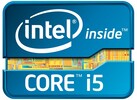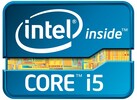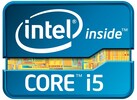Intel Core i5-2467M vs Intel Core i5-2520M vs Intel Core i5-2537M
Intel Core i5-2467M
► remove from comparison
The Intel Core i5-2467M is power efficient ULV (Ultra Low Voltage) processor for thin and light laptops. The base frequency of 1.6 GHz is relatively low, but due to Turbo Boost 2.0, the CPU may clock up to 2.3 GHz (one core loaded, 2GHz with both cores loaded). However, this is depending on the cooling and power consumption of the laptop. Due to HyperThreading, the i5-2467M is able to handle 4 threads in parallel. Compared to the slightly slower i5-2537M, the 2467 offers a faster base speed (1.6 vs 1.4GHz).
Sandy Bridge is the evolutionary successor of the Arrandale architecture. The most noteable improvements is the improved Turbo 2.0 and the integration of the graphics card into the 32nm CPU core. The 2467M offers not all features of the Sandy Bridge core, e.g. VPro, VT-d or Trusted Execution are not enabled.
The integrated Intel HD Graphics 3000 clocked at 350 or 1150MHz (Turbo Boost). Due to the slower clock rate, compared to other HD Graphics 3000 (usually 650-1100/1300MHz in non LV processors), the performance should be noticeable lower.
The performance of the CPU should be a bit higher than a similar clocked Arrandale Core i5. Therefore, the performance should be similar to a Core i7-680UM / Core i3-330M.
The TDP of 17W (includes the integrated GPU and memory controller) allows the use of the 2467M CPU in small subnotebooks.
Intel Core i5-2520M
► remove from comparison
The Intel Core i5-2520M is a fast dual-core processor released in Q1 2011. It is based on the Sandy Bridge architecture and offers Hyperthreading to run 4 threads simultaneously. Compared to the faster Core i7 family, the i5 offers smaller L3 cache at just 3MB. The base clock speed is 2.5 GHz with Turbo Boost potential up to 3 GHz for 2 active cores and 3.2 GHz for 1 active core.
Sandy Bridge is the evolutionary successor of the Arrandale architecture. The most notable improvements are the new 256-Bit AVX instructions, updated Turbo Boost 2.0, and the integration of a GPU onto the same 32 nm die.
The i5-2520M offers an integrated graphics card (Intel HD Graphics 3000) that is clearly faster than the older Intel HD Graphics in Arrandale CPUs. The GPU shares the same fast L3 cache with the CPU cores by utilizing a new ring bus. GPU clock rates in the 2520M core can run from 650 MHz up to 1300 MHz with Turbo Boost.
Furthermore, an improved dual-channel DDR3 memory controller is included and shared between the CPU and GPU.
Due to the new architecture and updated Turbo Boost 2.0, the average performance of the Core i7-2540M is higher than a similarly clocked Arrandale Core i5. Its performance in synthetic benchmarks should be similar to the old Core i5-560M for demanding workloads.
The 35W TDP rating includes the integrated GPU and memory controller as well as the CPU itself.
Intel Core i5-2537M
► remove from comparison
The Intel Core i5-2537M is power efficient ULV (Ultra Low Voltage) processor for thin and light laptops. The base frequency of 1.4 GHz is relatively low, but due to Turbo Boost 2.0, the CPU may clock up to 2.3 GHz (one core loaded, 2GHz with both cores loaded). However, this is depending on the cooling and power consumption of the laptop. Due to HyperThreading, the i5-2537M is able to handle 4 threads in parallel.
Sandy Bridge is the evolutionary successor of the Arrandale architecture. The most noteable improvements is the improved Turbo 2.0 and the integration of the graphics card into the 32nm CPU core.
The integrated Intel HD Graphics 3000 clocked at 350 or 900MHz (Turbo Boost). Due to the slower clock rate, compared to other HD Graphics 3000 (usually 650-1100/1300MHz in non LV processors), the performance should be noticeable lower.
The performance of the CPU should be a bit higher than a similar clocked Arrandale Core i5. Therefore, the performance should be similar to a Core i7-680UM / Core i3-330M.
The TDP of 17W (includes the integrated GPU and memory controller) allows the use of the 2537M CPU in small subnotebooks.
| Model | Intel Core i5-2467M | Intel Core i5-2520M | Intel Core i5-2537M | ||||||||||||||||||||||||||||||||||||||||||||||||||||||||||||||||||||||||||||||||||||||||||||||||||||||||||||||||||||||||
| Series | Intel Core i5 | Intel Core i5 | Intel Core i5 | ||||||||||||||||||||||||||||||||||||||||||||||||||||||||||||||||||||||||||||||||||||||||||||||||||||||||||||||||||||||||
| Codename | Sandy Bridge | Sandy Bridge | Sandy Bridge | ||||||||||||||||||||||||||||||||||||||||||||||||||||||||||||||||||||||||||||||||||||||||||||||||||||||||||||||||||||||||
| Series: Core i5 Sandy Bridge |
|
|
| ||||||||||||||||||||||||||||||||||||||||||||||||||||||||||||||||||||||||||||||||||||||||||||||||||||||||||||||||||||||||
| Clock | 1600 - 2300 MHz | 2500 - 3200 MHz | 1400 - 2300 MHz | ||||||||||||||||||||||||||||||||||||||||||||||||||||||||||||||||||||||||||||||||||||||||||||||||||||||||||||||||||||||||
| L1 Cache | 128 KB | 128 KB | 128 KB | ||||||||||||||||||||||||||||||||||||||||||||||||||||||||||||||||||||||||||||||||||||||||||||||||||||||||||||||||||||||||
| L2 Cache | 512 KB | 512 KB | 512 KB | ||||||||||||||||||||||||||||||||||||||||||||||||||||||||||||||||||||||||||||||||||||||||||||||||||||||||||||||||||||||||
| L3 Cache | 3 MB | 3 MB | 3 MB | ||||||||||||||||||||||||||||||||||||||||||||||||||||||||||||||||||||||||||||||||||||||||||||||||||||||||||||||||||||||||
| Cores / Threads | 2 / 4 | 2 / 4 | 2 / 4 | ||||||||||||||||||||||||||||||||||||||||||||||||||||||||||||||||||||||||||||||||||||||||||||||||||||||||||||||||||||||||
| TDP | 17 Watt | 35 Watt | 17 Watt | ||||||||||||||||||||||||||||||||||||||||||||||||||||||||||||||||||||||||||||||||||||||||||||||||||||||||||||||||||||||||
| Transistors | 624 Million | 624 Million | 624 Million | ||||||||||||||||||||||||||||||||||||||||||||||||||||||||||||||||||||||||||||||||||||||||||||||||||||||||||||||||||||||||
| Technology | 32 nm | 32 nm | 32 nm | ||||||||||||||||||||||||||||||||||||||||||||||||||||||||||||||||||||||||||||||||||||||||||||||||||||||||||||||||||||||||
| Die Size | 149 mm2 | 149 mm2 | 149 mm2 | ||||||||||||||||||||||||||||||||||||||||||||||||||||||||||||||||||||||||||||||||||||||||||||||||||||||||||||||||||||||||
| max. Temp. | 100 °C | 100 °C | 100 °C | ||||||||||||||||||||||||||||||||||||||||||||||||||||||||||||||||||||||||||||||||||||||||||||||||||||||||||||||||||||||||
| Socket | BGA1023 | rPGA988B / BGA1023 | BGA1023 | ||||||||||||||||||||||||||||||||||||||||||||||||||||||||||||||||||||||||||||||||||||||||||||||||||||||||||||||||||||||||
| Features | HD Graphics 3000 (350-1150MHz), DDR3-1066/1333 Memory Controller (max 8GB), HyperThreading, AVX, Quick Sync, Virtualization | HD Graphics 3000 (650-1300MHz), DDR3-1066/1333 Memory Controller (max 8GB), HyperThreading, AVX, Quick Sync, Virtualization | HD Graphics 3000 (350-900MHz), DDR3-1066/1333 Memory Controller (max 8GB), HyperThreading, AVX, Quick Sync, Virtualization | ||||||||||||||||||||||||||||||||||||||||||||||||||||||||||||||||||||||||||||||||||||||||||||||||||||||||||||||||||||||||
| iGPU | Intel HD Graphics 3000 (350 - 1150 MHz) | Intel HD Graphics 3000 (650 - 1300 MHz) | Intel HD Graphics 3000 (350 - 900 MHz) | ||||||||||||||||||||||||||||||||||||||||||||||||||||||||||||||||||||||||||||||||||||||||||||||||||||||||||||||||||||||||
| Architecture | x86 | x86 | x86 | ||||||||||||||||||||||||||||||||||||||||||||||||||||||||||||||||||||||||||||||||||||||||||||||||||||||||||||||||||||||||
| $250 U.S. | $225 U.S. | $250 U.S. | |||||||||||||||||||||||||||||||||||||||||||||||||||||||||||||||||||||||||||||||||||||||||||||||||||||||||||||||||||||||||
| Announced | |||||||||||||||||||||||||||||||||||||||||||||||||||||||||||||||||||||||||||||||||||||||||||||||||||||||||||||||||||||||||||
| Manufacturer | ark.intel.com | ark.intel.com | ark.intel.com |


 Deutsch
Deutsch English
English Español
Español Français
Français Italiano
Italiano Nederlands
Nederlands Polski
Polski Português
Português Русский
Русский Türkçe
Türkçe Svenska
Svenska Chinese
Chinese Magyar
Magyar
